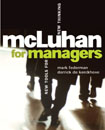me | probes | managers | virtual | space
McLuhan for Managers: New Tools for New Thinking (2003) by Mark Federman
and Derrick de Kerckhove, is an explication and application of some of McLuhan's
often misunderstood heuristics and aphorisms, like "figure/ground," the role
of clichés, and the laws of media. While the identified audience is "managers,"
the clarity of definitions and applications serves as an excellent introduction
to McLuhan's analytical and predictive tools, more so than an introduction to
or re-assessment of the scholar. In addressing managers, it could be of particular
value to Writing Program Administrators or other members of the academic managerial
class. The Medium is the Message: "In McLuhan's world a Medium is
anything that extends our mind, body or senses. It could be a new technology
or gadget. It could be a new process. An idea or original, creative work is
a Medium. Anything we create or build, anything we conceive, any expression
of humankind is a McLuhanesque Medium. Media – more than one Medium –
can be concrete and tangible or they may be abstract and intangible." (23)
The Laws of Media: As a starting point for analysis of a Medium,
four laws can be applied to, or four questions can be asked of, that Medium:
What is being retrieved? What is being enhanced? What will become of the medium
when taken to its extreme, or reversed, and What is being obsolesced? "All
of these effects occur in the Medium at once, simultaneously. It is not that
one or the other occurs at different times, nor does one cause or lead to
another" (81). The remaining four chapters apply these terms and methods to a variety of contemporary
communication technologies and processes like internet shopping, television,
jobs and roles, and connected intelligence, to name a few.  Federman, Mark, and Derrick de Kerckhove. McLuhan for Managers: New Tools
for New Thinking. Toronto: Viking Canada, 2003.
Federman, Mark, and Derrick de Kerckhove. McLuhan for Managers: New Tools
for New Thinking. Toronto: Viking Canada, 2003.
The first four chapters of the book provide
background on McLuhan, his terminology, and his methods, including explanations
of key terms like cliché tuning, media temperatures (hot and cool), and the
following that form the core of the "new tools": Figure/ground: figure is the new, ground is the familiar, and
the relationship is dynamic. "McLuhan told us that 'nothing has meaning alone.'
Something may exist in isolation, but its meaning – and by extension its
value – is derived solely as a function of the context or environment in
which it exists" (18).
This quick and succinct defining and employing
of McLuhan terminology makes for a unique contribution to the McLuhan revival
because the rest of the books under review concentrate on one or two aspects
of McLuhan's work (his views of space, his identity as trickster and poet, his
probes), while the Federman and de Kerckhove book synthesizes the rich McLuhan
set of practices in readable prose that emulates the best of McLuhan's stylistic
tendencies, but strives also for explanation, not just exploration.
I have had success employing figure/ground
and the Laws of Medium in tandem as part of an upper-level course in Electronic
Communication, and while I did not use this book I borrowed heavily from Mark
Federman's seminar notes "Through
a McLuhan Lens." The cliché tuning exercise described in chapter three seems
likely to be an interesting exercise for a business communication class, one
that could function to increase students' sensitivity to the language they use,
and simply function as an engaging small group exercise.
I was also pleasantly surprised to realize
how helpful and provocative this book could be for me as a Writing Program Administrator.
I have already been thinking of myself as involved in knowledge management,
but I have been reluctant to seek campus wide input on the first year sequence
we offer. The final chapter on "Connected Intelligence" not only provides a
rationale seeking the input of experts and non-experts within an organization,
but provides a formula for a "Connected Intelligence Playshop" and "Tips for
Playing Well."
With such a project, covering so much ground
and offering up so many examples of thinking in action, comes some short cuts
and over-generalizations. The definition of "the Medium," cited above, leaves
one to wonder, what isn't a medium? McLuhan himself offered a more precise definition,
available in Understanding Me, which suggests that he certainly did not
think of any and all inventions as the medium, and he did not think of the figure
as the object most worthy of attention. Federman and de Kerckhove certainly
understand the importance of ground, but their encompassing definition of Medium
seems to push analytical emphasis in the wrong direction. The message is in
the ground. A single paragraph attributing to McLuhan a correspondence theory
of Truth (45) will likely send up a red-flag for those in rhetoric and composition
who have been working towards more nuanced coherence theories of truth, but
the authors do not linger on the point.
Ultimately this book is pragmatic rather than
academic, focused on the thinking tools, and it can serve as an excellent resource
for a variety of courses and a variety of roles we play in our institutions.

